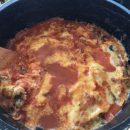 Some people see a glowing hot stream of lava and think: "Wow. Looks dangerous; I better keep away from that." But another, more daring group, says: "Wow. I bet I could cook a chicken on that!"
Some people see a glowing hot stream of lava and think: "Wow. Looks dangerous; I better keep away from that." But another, more daring group, says: "Wow. I bet I could cook a chicken on that!"
We call those people "Extreme Chefs," a group of culinary adventurers who spurn the stove, microwave, and backyard grill. They'll cook anywhere else - and with anything else - though: car engines, dishwashers, compost piles, steam irons, and even volcanoes.
Car-beque Anyone?
Chris Scheller and Chris Maynard's automotive cookbook, "Manifest Destiny," is a lighthearted and varied collection of recipes designed for your car engine. The book tackles such heated topics as "were Jaguars really designed with veal scallopini in mind?" and "how many miles does it take to poach a salmon?"
Last published in 1998; used copies of "Manifold Destiny" are sought after by collectors and hungry truckers. Don't worry if you can't locate one. These basic guidelines will help you convert your Subaru into a mobile Spago:
When the engine is warm, carefully use your hand to find the places that are hot enough – and large enough to cook your entree.
Wrap the food in aluminum foil (several layers) and seal it well.
Secure the packet. Otherwise, your car may leave a Goldilocks-like trail of half-cooked shrimp on the highway.
Guard against leaks. Lemon juice and other liquids can corrode your engine.
Chicken and fish do best for short (under 100-mile) trips because they tend to cook more quickly.
This is an inexact science, and it may take several attempts to get the recipe just right. If at first you don't succeed, drive, drive again!
Even if you don't own a car, there are other ways to avoid the stove and still cook great food. All it takes is a little imagination and a few common household appliances.
Dishwasher Dinners
Most people run the dishwasher after the meal, but to others, the sound of water churning through the appliance says just one thing: "Dinner's almost ready!"
That's right, it's possible to cook in your dishwasher. Bob Blumer, host of the Food Network show, "The Surreal Gourmet," popularized dishwasher cooking when he showed how to poach salmon in a dishwasher. Fish is often the best option. Its cooking requirements almost exactly match the temperature and time of an average dishwasher cycle.
Things to remember:
Wrap the fish in aluminum foil and seal it well.
Enclose each portion in its own foil pouch.
Oil the inside of the foil to keep the fish from sticking.
This is a great energy-saving technique because it's perfectly acceptable to wash a load of dishes (with soap) as you cook the fish. Just make sure the foil is sealed really, really well.
Snacks From Your Iron
But perhaps you're not looking for a full meal, just a snack as you catch up on the ironing. How about a grilled cheese sandwich?
Select the Wool setting on your iron and assemble your ingredients:
1. Cheese: Choose your favorite type and slice it thinly. Grated cheese melts more quickly, but makes a bigger mess.
2. Bread slices: Thick, sturdy slices work best. Avoid thin, soft slices of white bread; the iron tends to flatten them.
3. Butter or margarine: Spread on the outside of the bread to help it toast and prevent sticking.
When your sandwich is assembled, make sure the Steam setting is turned to OFF before applying the iron. For best results, use an iron with Teflon coating on the bottom. It makes cleanup much easier if the cheese leaks out.
Giving Thanks With Compost
This technique requires a sizeable compost pile and the willingness to risk food poisoning.
One year, master composter Malcolm Beck decided to try something new for Thanksgiving. He sealed a couple of turkeys in several layers of plastic bags and lowered them by rope into the middle of one of his large (8+ feet tall) compost piles. The turkeys cooked for several hours, using the heat generated by the compost pile, and reportedly were delicious.
Although imaginative and unique, this isn't a recommended cooking method. Compost pile temperatures just don't get hot enough to kill harmful bacteria. Mr. Beck's compost temperature measured between 160 and 180 degrees Fahrenheit and that's not always high enough to kill harmful bacteria. The USDA recommends temperatures no lower than 325 degrees for cooking poultry.
This next extreme outdoor cooking technique can be even more dangerous because, well, you may not live to taste the food.
Cooking With Lava
Think of it as a way to get in touch with your inner caveman. John Alexander, owner of the Dolphin Bay Hotel in Hilo, Hawaii, devotes a page of his Web site to his own special recipe and describes how to cook with lava.
The tools and ingredients are about what you'd expect:
1. A supply of molten lava: approximately 2 shovels full.
2. Game hen.
3. Heavy protective gloves
4. A shovel that you'll never use again.
5. Eight banana leaves
Wrap the meat in the banana leaves (leave a small opening to vent escaping steam) and place it on one scoop of the lava. This becomes the base of the "oven." Top the leaves with the other scoop of lava and let it cool. Within about 45 minutes, the lava cools; the banana leaves burn to ash; and your hen is ready to eat. Opening your "oven" is easy: just hit the hardened lava with your shovel.
Safety tip: be sure to select a slow-moving lava flow. Some have been clocked at speeds up to 37 miles per hour.
Five-minute Ice Cream
Now let's end our culinary adventure with some dessert. How about a frosty bowl of liquid nitrogen ice cream?
You'll need:
1. Liquid nitrogen: Approximately 2 liters for an average recipe. Check with your local liquid gas suppliers and be sure to compare prices. Some suppliers charge extra for delivery or container rental.
2. Heavy gloves: The liquid nitrogen is cold enough to freeze your skin on contact. No ice cream social should end with a trip to the emergency room, so be careful handling the ingredients.
3. Your favorite ice cream recipe.
4. Stainless steel mixing bowl: The larger, the better.
5. Wooden spoon for combining the ice cream mixture and the liquid nitrogen.
Put on the gloves and pour the ice cream mixture into the stainless steel mixing bowl. Slowly pour the liquid nitrogen to the ice cream and stir with the wooden spoon until the mixture is frozen and the nitrogen has evaporated. This should take five to ten minutes. Serve immediately. Stir in more liquid nitrogen if the mixture melts too quickly.
Although you may never be tempted by the world of extreme cooking, these techniques do supply you with interesting conversation topics for your next dinner party. Nobody needs to know that you prepared the food using a boring, conventional stove.
Sources:
Cooking with Volcanoes
Dishwasher Salmon with Cilantro Sauce
Grilled Cheese with a Steam Iron
Liquid Nitrogen Ice Cream
Making Ice Cream with Liquid Nitrogen
Trash Can Turkey
Turkey for the Holidays





Impressive information&great site.